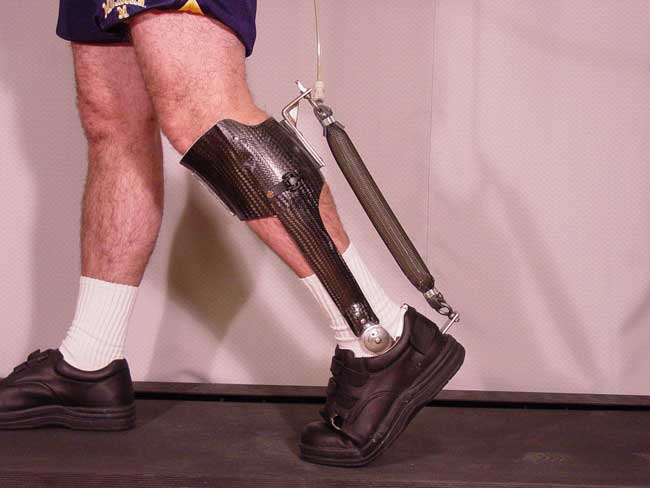Robotic Exoskelton Could Help People Walk

A robotic ankle exoskeleton developed at the University of Michigan helps people regain limb function; it is controlled by the wearer's own nervous system. [See video.] As the subject attempts to walk forward, electrical impulses from the brain tell muscles how to move. People with spinal injuries, as well as some neurological disorders, may have problems walking because these impulses do not arrive in a coordinated fashion, or because the impulses are too weak. The ankle exoskeleton uses the brain's electrical signals to know what to do and how to move. Electromyography (EMG) signals are processed in real time by a computer; the signals are used to control air pressure supplied to the artificial pneumatic muscle (see picture).
"This could benefit stroke patients or patients with incomplete injuries of the spinal cord," said Daniel Ferris, associate professor in movement science at U-M. "For patients that can walk slowly, a brace like this may help them walk faster and more effectively."
Science fiction fans have long been familiar with the idea of a powered suit that responds directly to the user's muscles and amplifies their function. In a sense, the UM invention is the opposite; it provides simple assistance so that the wearer can strengthen or regain lost function. I'm also fascinated by the sense in which the robotic ankle exoskeleton's computer system helps to interpret and strengthen the signals produced by the wearer's nervous system. As the science fiction example of an exoskeleton, I've chosen the titanium exoskeleton from Fritz Lieber's excellent 1968 novel A Specter is Haunting Texas. In the story, a man who had grown up in weak gravity comes to Earth and needs support just to stand up.
This truly magnificent, romantically handsome, rather lean man was standing on two corrugated-soled titanium footplates. From the outer edge of each rose a narrow titanium T-beam that followed the line of his leg, with a joint (locked now) at the knee, up to another joint with a titanium pelvic girdle and shallow belly support. From the back of this girdle a T-spine rose to support a shoulder yoke and rib cage, all of the same metal. The rib cage was artistically slotted to save weight, so that curving strips followed the line of each of his very prominent ribs.(Read more about the titanium exoskeleton)
There are other examples of this kind of strengthening exoskeleton in the real world (as opposed to the science-fictional one). The Robotics and Mechatronics Laboratory of Northeastern University developed the AKROD v2 - Active Knee Rehabilitation Device . This device uses a computer-controlled knee joint filled with magnetorheological fluid to provided graded resistance to help patients regain function. See also a new device to help people with manual dexterity problems following a stroke - the HOWARD Hand-Wrist Assisting Robotic Device. Read more about the UM's Robotic exoskeleton; this research provides a real basis for applications in rehab and physical therapy. (This Science Fiction in the News story used with permission from Technovelgy.com - where science meets fiction.)
- Vote: Real Robots
- The Weirdest Science Stories of 2006
- Build Your Own Robot
- The World's Smallest Robot
- All About Robots
Get the world’s most fascinating discoveries delivered straight to your inbox.


